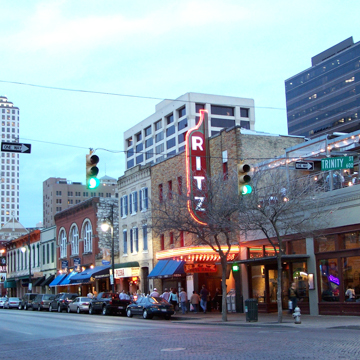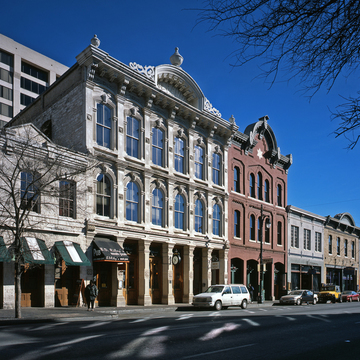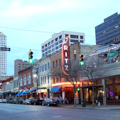You are here
East Sixth Street Historic District
Located in the heart of downtown, the 6th Street Historic District has become a symbol of Austin’s unique cultural vitality and diversity. Formerly known as Pecan Street, the historic avenue appeared on Edwin Waller’s first maps of Austin as early as 1839. Pecan Street became Sixth Street in 1884 when the city outgrew its original nomenclature, which used native tree names for the first 14 east-to-west blocks.
Relatively flat and just beyond the reach of the Colorado River flood plain, Pecan Street was well suited for commercial development in the city’s early history. While the Civil War interrupted Sixth Street's growth in the 1860s, the area grew as a commercial center. The arrival of the railroad in 1871 strengthened the neighborhood, as some of Austin's most successful businesses sought to locate their facilities near the railroad depot. In time, two- and three-story Victorian buildings lined the streets, lending elegance and glamour to the neighborhood.
In addition to functioning as a farm-to-market thoroughfare, the street was inhabited by a diverse group of settlers and entrepreneurs. These included Austin’s first African American resident, Mahala Murchison, who arrived in 1839, and Ed Carrington, who became Austin’s first African American property owner in 1872. While the rest of Austin was segregated under Jim Crow, Sixth Street remained open to all.
Beyond its black and white denizens, Lebanese, Chinese, Jewish, and Hispanic populations contributed significantly to the area’s development. In the early to mid-1900s, 6th Street was the center of commercial and social life for Austin’s Hispanic community. The street hosted Austin’s first Tex-Mex Restaurant, as well as one of the few Chinese restaurants in the area established before 1900. This kind of diversity paved the way for Austin to foster one of the most renowned culinary scenes in the country.
During the late 1880s, however, Congress Avenue began to compete with 6th Street as a fashionable shopping destination. Sixth Street continued to host offices, warehouses, and showrooms for railroad-dependent enterprises but it was no longer the commercial success it had once been. A steady erosion of the commercial importance of the 6th Street neighborhood grew clearer in the 1940s as businesses left for the then more vibrant downtown area. In time, 6th Street harbored an increasingly notorious bar scene, earning it the nickname “Dirty 6th.” After World War II, the historic street saw a steady economic decline in tandem with an increasingly seedy reputation.
In the late 1970s, however, 6th Street began to regain its earlier cultural importance, and was listed as a historic district on the National Register of Historic Places. In the 1980s, East 6th Street emerged as the center of revitalization in Austin with the adaptive reuse of several important buildings on the street extending from Congress Avenue east to I-35. However, it was the rehabilitation of the Thaison Building at 410 E. 6th (1882; 1967 conversion, David C. Graeber) and the four buildings of Hannig Row at number 200 (1876; 1983, Bell, Klein and Hoffman) that set the pace for a full-scale revitalization. The mixed use of housing, retail, entertainment, and offices established an almost–twenty-four-hour urban lifestyle on this once forgotten street. The Littlefield Mall (1981, Holt+Fatter+Scott), at 121 E. 6th, attempted to bring mixed service and retail businesses together using a mall concept.
Today, despite the district’s fluctuating prosperity and significant redevelopment, 6th Street manages to retain much of its Victorian charm, reflecting the height of its commercial and cultural success. Advocates for Old Pecan Street currently claim the street hosts the largest concentration of Victorian commercial architecture west of the Mississippi, including landmarks such as the elegant Driskill Hotel and the Morley Bro’s Drug Store Building, which now houses Austin’s visitors' center. The street retains the scale of these Victorian buildings while towers can be seen in the background. The sidewalks are wide enough to encourage pedestrians and the street is easily crossed, since it has preserved its original width.
In recent years 6th Street’s renown has continued to grow. The historic street houses restaurants, art galleries, and over 80 live music venues that feature everything from blues and country to rock and hip hop. In addition to a multitude of smaller festivals, the biannual Pecan Street Festival, one of the nation’s largest art and music festivals, draws hundreds of thousands of visitors to 6th Street each year, with another 172,000 people attending Austin’s annual South by Southwest Festival. Contentious plans for continued development render the future of 6th Street unclear. Its deeply rooted community, however, is committed to maintaining the historic street’s robust cultural identity.
References
Childs, Allen. Sixth Street. Charleston, SC: Arcadia, 2010.
Corcoran, Michael. “Austin's ‘Street of Dreams’: From Pecan Street to Dirty Sixth.” Arts+Labor Magazine, March 27, 2014.
Writing Credits
If SAH Archipedia has been useful to you, please consider supporting it.
SAH Archipedia tells the story of the United States through its buildings, landscapes, and cities. This freely available resource empowers the public with authoritative knowledge that deepens their understanding and appreciation of the built environment. But the Society of Architectural Historians, which created SAH Archipedia with University of Virginia Press, needs your support to maintain the high-caliber research, writing, photography, cartography, editing, design, and programming that make SAH Archipedia a trusted online resource available to all who value the history of place, heritage tourism, and learning.









